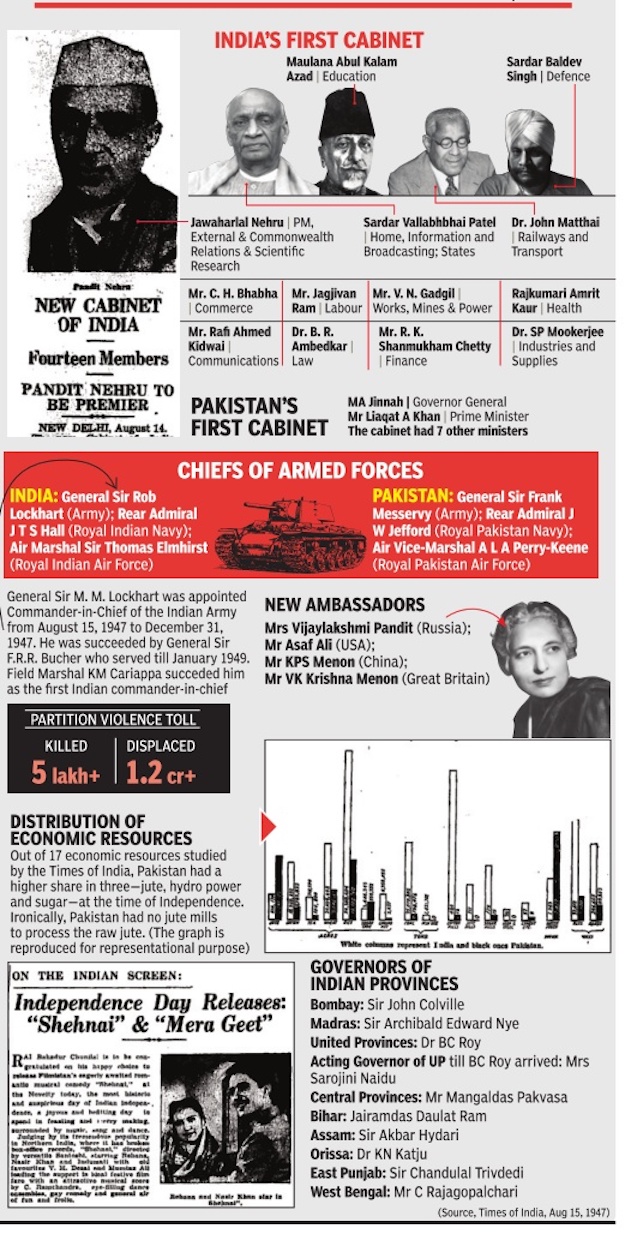India, A brief history: 1947 onwards






This is a collection of articles archived for the excellence of their content. |
1947: Partition; the first cabinets
See graphic: State of two then newly independent nations, India and Pakistan, as on August 15, 1947

1947-67: a history of the early years
Aug 15 2017 : The Times of India (Delhi)
INDIA: AN UNAUTHORISED BIOGRAPHY PEOPLE, EVENTS, POLICIES
1 Words to live by
Among the 20th century's stirring speeches is Nehru's `Tryst with Destiny' address to the Constituent Assembly at midnight, August 14, 1947, marking the transition to freedom. Laying out the vision for free India in 820 words, India's first PM talked of peace and service, foregrounding the themes of welfare and security in public discourse.
2 The Constitution's architect
A radical thinker rarely in agreement with Gandhians and Congress, B R Ambedkar was still appointed law minister in Nehru's first cabinet and tasked with raising a framework for modern India. He chose to underpin it with the principles of equality and justice, placing emphasis on individual rights rather than traditions, communities, and ideology. The idea of a strong Centre within a federal system of governance were also underscored through his arguments.A rare photo of Dr Ambedkar after his conversion to Buddhism
3 Bhasha battles
The language question loomed large much before states were reorganised on linguistic lines.
From the 1930s, Periyar opposed Rajaji's efforts to popularise Hindi in Tamil Nadu (Madras Presidency), and later DMK turned the stir into a movement that swept them to power.
4 India's heroes
Raj-Dilip-Dev: The troika that lorded over Bombay cinema and the nation's heart in the 1950s-60s. Dilip Kumar typified bottled, moody passion; Dev Anand was the urbane, debonair male; Raj Kapoor, the heart-of-gold, Chaplinesque hero in Nehruvian movies with songs (Awara hoon, Mera joota hai Japani) that became timeless anthems.
DID YOU KNOW?
Raj & Dilip acted together in Andaz. Dilip & Dev were lead performers in Insaniyat. Raj & Dev never shared the same screen space.
5 Song of the road
Pather Panchali, Satyajit Ray's lyrical debut feature (1955), put India on the map of world cinema and became the benchmark for every aspiring Indian auteur.
6 Road maps
India had 12 five-year plans for the economy since 1951.Although scrapped in favour of Niti Aayog's three-year action plans, the USSR-inspired plans are the reason one can drive from Kashmir to Kanyakumari without starving on the way.
7 Rise of the Reds
In 1957, the first-ever elected communist government was formed in Kerala with EMS becoming the chief minister. Invoking Article 356, PM Nehru dismissed the EMS govt in 1959, after it initiated radical land reforms and an overhaul of the education system.
8 Temples of modern India
Massive hydel projects (Bhakra Nangal, Hirakud) built in the 1950s-60s became emblems of Nehruvian development.
They set the stage for the Green Revolution but lost their sheen by the 1990s, and activists campaigned actively against them.Picture of Hirakud Dam on a Rs 100 note
9 At war
The Indian Army, its reputation burnished by WWII, was handed a morale-wrecking defeat in the Himalayas by China's PLA which came with overwhelming numbers and superior firepower.The Army's prestige was crushed, as was Nehru's spirit.
10 Peasants, workers unite
The summer of '67 uprising by peasants and tea garden workers in the picture-postcard north Bengal village of Naxalbari created the template for armed, radical Left movements that continue to thrive in swathes of India Ignored.Busts of Lenin, Stalin, Mao and Charu Mazumdar in Naxalbari